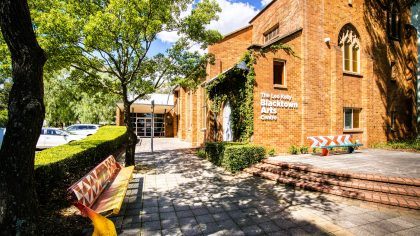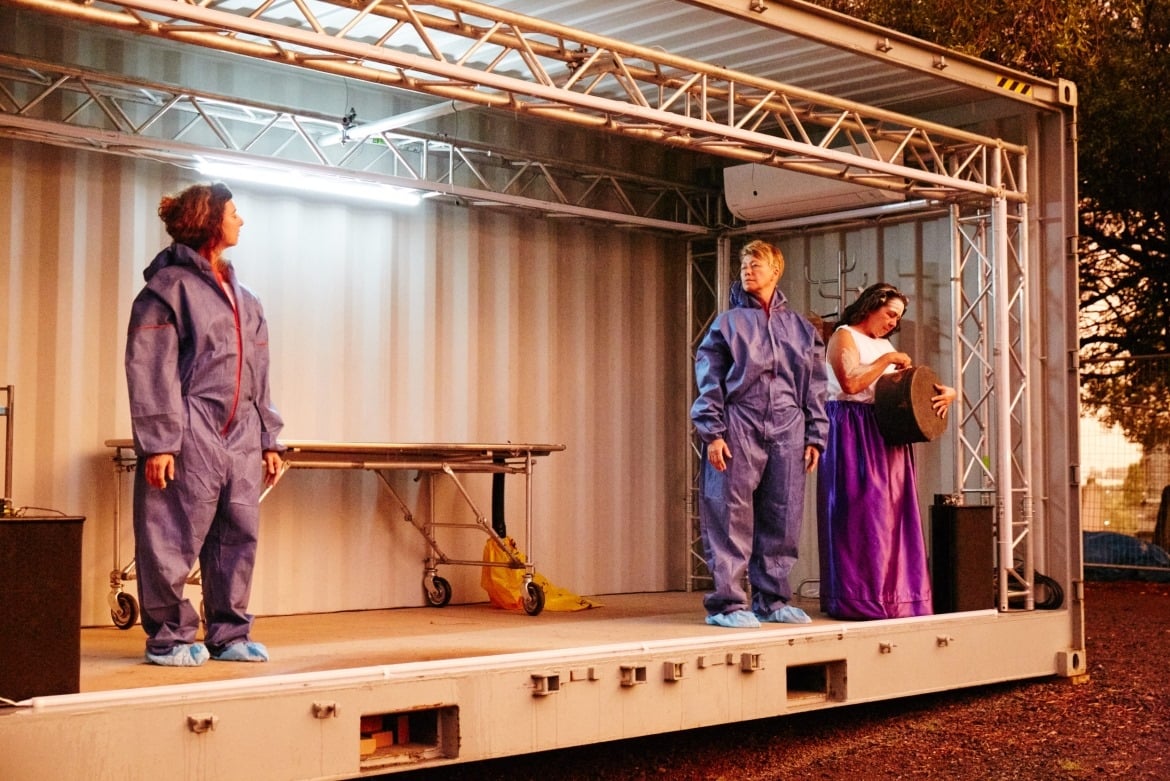
The Leo Kelly Blacktown Arts Centre
An innovative multi-arts hub in the heart of Blacktown City.
Bayadyinyang budyari Dharug yiyura Dharug Ngurra.
Bayady’u budyari Dharug Warunggadgu baranyiin barribugu.
Bayady’u budyari wagulgu yiyuragu Ngurra bimalgu Blacktown City. Flannel flowers dyurali bulbuwul.
Yanmannyang mudayi Dharug Ngurrawa. Walama ngyini budbud dali Dharug Ngurra Dharug yiyura baranyiin barribugu.
We acknowledge the Traditional Custodians of this Land, the Dharug people, and their continued connection to Country.
We pay our respects to Elders from yesterday to tomorrow.
We extend that respect to all Aboriginal and Torres Strait Islander Peoples of Blacktown City where the flannel flowers still grow proud and strong.
We will walk softly on this land and open our hearts to Country as the Dharug people have for tens of thousands of years.
Credit to: Dharug woman Rhiannon Wright, daughter of Leanne ‘Mulgo’ Watson Redpath and granddaughter of Aunty Edna Watson

With mounting anticipation we are transported by bus from The Leo Kelly Blacktown Arts Centre to St Bartholomew’s Church in Prospect, the site of the evening’s performance of Broken Glass. It’s VIP night, so a good number of Blackfellas are in attendance for the maiden event, a roving performance installation throughout the chapel and grounds.
After a smoking ceremony held by local Elder Uncle Wes Marne, we walk single file into a small hall which looks like the ideal spot for girl guides or scouts to learn and earn their merit badges. Except our leaders are dressed in spare white smocks and, instead of pledging an oath of allegiance, they greet us with commiserations. An Aunty has died. We become a part of an extended family assembled in remembrance.
Soon enough good intentions give way to avaricious intent as a farcical stocktake of meagre possessions is claimed and counter claimed. Before all is lost, the escalating tension is broken by the distracting absence of a beloved budgie, Nathan.
As the three women reconcile, a lone figure enters dressed in a purple floor-length colonial skirt. She clutches a round case close to her chest, individually taking us in before asking for something to drink, or perhaps a morsel to eat. As she leaves, she beckons us to follow her. This woman will be represented by each actor in turn as we are guided to each site. We later learn she is a Darug woman, although she could be the ancestor of many urban Blackfellas, forced into the fold of colonial culture.
This is a delicate three-hander placing the fundamental incompatibility between the Indigenous and colonial ways of being at the forefront of the episodic narrative. From loud familial comedic role play, to the clinical treatment processing of the morticians’ rooms, where the mix of responsibility and revulsion is expressed through prose peppered with equal measures of procedural jargon and personal anecdotes. From the church to the grave site, we are gradually immersed into a multifaceted cultural experience of loss, where the ecclesiastical and spiritual are articulated in equal measure.
Embedded with Indigenous knowledge practices, Broken Glass acts as a song cycle, an indigenous primer ensuring perpetuity for the next generations to utilise, as well as a work of entertainment. Broken Glass stands as a poignant testament to the ways in which Aboriginal culture has adapted.
The light-hearted opening is a clever device and before you know it you are embroiled. Invested. The tables have momentarily turned and it is the general public who are taken into the fold.
Moments not to miss:
Performer Andrea James wide-eyed stare of pious incredulity as she makes a self righteous bid for the microwave while the body lay directly behind in a wicker casket.
The cylindrical back and forth of Andrea and Liza-Marie Syron
describing the morticians’ experience.
Karen Norris’ lighting in the church creating an all-encompassing stained-glass effect as dancer/performer Katie Leslie moves with steady solemnity.
The unfolding tableaux (also in the church) reminiscent of Australian modern dance pioneer Margaret Barr’s women in Hebridean Suite, which begins with the four women as they process through the bracken mound installations and ending with their colonial selves looking prophetically to a future filled with bustling automation as they faced the motorway.
The broken glass memorial plots that twinkle like jewels.
The curious mourning head pieces which prompt us to contemplate the event with fresh eyes, as if from another planet.
Lily Shearer’s haunting wail for lost souls in the recessed alcove filled with funeral programs attached to the walls followed by the town’s elders affectionately clutching the same notes, and the discovery that they are/were comprised of deceased loved ones.
The lighting on the trees accompanied by a sound score by Brenda Gifford that makes them appear like witnessing spirits, making sure that we are practicing right-way.
Broken Glass was presented by Moogahlin Performing Arts and Blacktown Arts for Sydney Festival 2018.